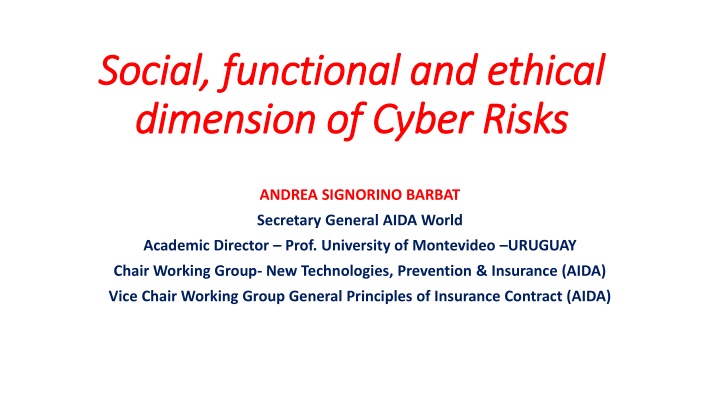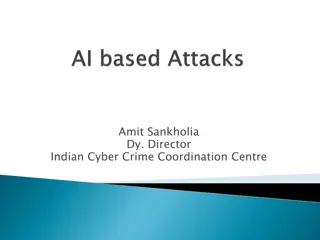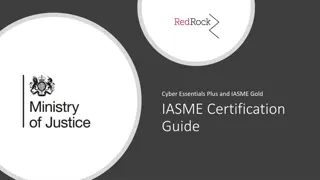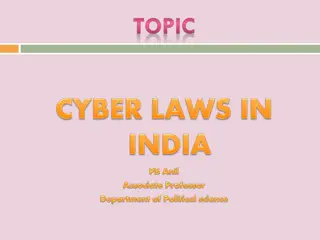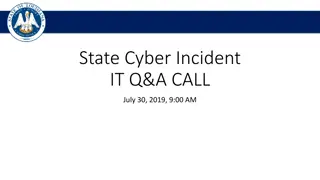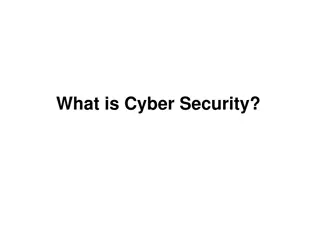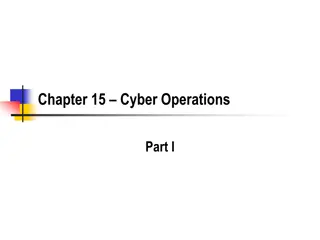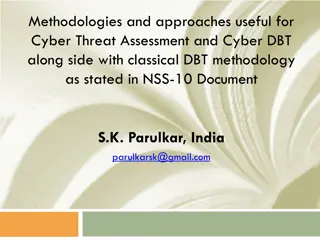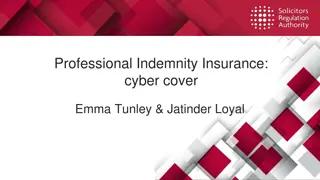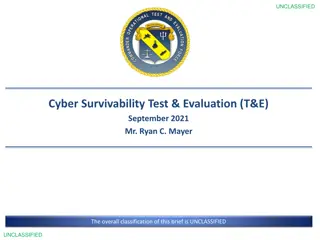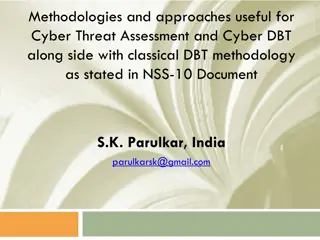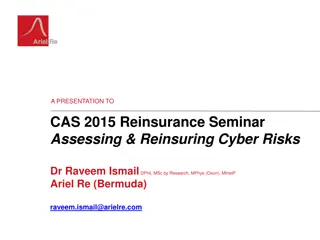Social, Functional and Ethical Dimensions of Cyber Risks
Andrea Signorino Barbat delves into the social, functional, and ethical dimensions of cyber risks, providing insights on the impact on consumers, internal risk management within insurance companies, and the ethical implications of handling cyber threats. Exploring the broad sense of cyber risks, the discussion highlights potential causes, solutions, and the vital importance of regulating and contextualizing risks in the cyber world.
Download Presentation

Please find below an Image/Link to download the presentation.
The content on the website is provided AS IS for your information and personal use only. It may not be sold, licensed, or shared on other websites without obtaining consent from the author.If you encounter any issues during the download, it is possible that the publisher has removed the file from their server.
You are allowed to download the files provided on this website for personal or commercial use, subject to the condition that they are used lawfully. All files are the property of their respective owners.
The content on the website is provided AS IS for your information and personal use only. It may not be sold, licensed, or shared on other websites without obtaining consent from the author.
E N D
Presentation Transcript
Social, functional and ethical Social, functional and ethical dimension of dimension of Cyber Cyber Risks Risks ANDREA SIGNORINO BARBAT Secretary General AIDA World Academic Director Prof. University of Montevideo URUGUAY Chair Working Group- New Technologies, Prevention & Insurance (AIDA) Vice Chair Working Group General Principles of Insurance Contract (AIDA)
New technologies: New technologies: TO BE OR NOT TO BE . TO BE OR NOT TO BE . to find the balance between to find the balance between ADVANTAGES AND RISKS . ADVANTAGES AND RISKS .
Goals Goals This does not purport to be a traditional approach referred to new technologies in the sense of introducing technologies applied to insurances and their risks, or comment about its virtues and flaws, or explain the types of existing Cyber risks. I intend to bring the subject closer to the audience while reflecting on Cyber risks in a broad sense.
Goals Goals We will analyze these type of risks as regards: - their social dimension: technologies and cybernetic world risks to the consumer insured within a social environment, possible causes and solutions. - their functional dimension: internal management of risks by insurance companies. - their ethical dimension, -perhaps the most important aspect, referred to the dangers the Cyber world may cause to people individually, as human beings, if risks are not properly handled, regulated or contextualized -.
General approach General approach What does What does cybernetic cybernetic mean mean? ? Cybernetic means anything related to interdisciplinary computing technology used to broaden human abilities. The word cybernetic comes from the greek kybernetes, meaning the art of steering a ship . Subsequently, it was used by Plato in his work The Republic in order to refer to the the art of ruling men or the art of governing .
What does What does cybernetic cybernetic mean mean? ? The modern concept of cybernetic, computing technology based on human communication, was coined by Norbert Wiener (1894-1964) in his work Cybernetics: or Control and Communication in the Animal and the Machine. Cybernetics studies information flows around a system, and how that information is used by the system as a value that allows the system to control itself: this happens for both animate and inanimate systems.
CYBER RISKS CYBER RISKS Cyber Risks: are the risks that lurk in Cyber space. They way beyond a hacker s action illegal cyber activities to extract, alter, modify, handle, render useless or destroy information or assets, of affected companies or users, using electronic means or electronic devices. Scope: Internal risk: generated or suffered by the actual person or company, External risk or regarding third parties: liability to third-party users or those related to the systems.
CYBER RISKS CYBER RISKS In this context we talk about computer fraud: one of the most modern challenges for the protection of individuals and companies from both organized or occasional criminals. Fraud includes data theft identity theft social network account theft cyber extortion and terrorism corporate espionage data handling vulnerability. Cyber attacks usually go against data flow, precluding communication between issuer and receiver, intercepting, modifying or making up data that alters the usual information flow.
CYBER RISKS CYBER RISKS The insurance activity is not safe from these risks We are living in the new technologies' era, the so-called Insurtech world, the application of new technologies to the insurance activity opens up a whole new world of new ways of conducting and making business. But of course, this also opens the door to Cyber risks.
1 1- - Cyber risks and their social dimension Cyber risks and their social dimension When talking about Cyber risks, we are immediately aware of SEVERAL LEGAL ASPECTS; THE MOST SIGNIFICANT ASPECTS ARE THE FOLLOWING ONES: - USERS DATA PROTECTION, - THEIR IDENTITY, - THEIR SAFETY.
Cyber risks and their social dimension Cyber risks and their social dimension BE AWARE! MANY OF THE RISKS COME FROM USERS THEMSELVES There is a considerable lack of awareness about whether the Internet is safe or not. This confusion among consumers hinders the fight against cyber crime. User support in technology education and its risks is quite dissimilar in the different countries, and this results in more or less aversion towards Cyber risks sometimes only prevention can save us from a cyber attack!
Cyber risks and their social dimension Cyber risks and their social dimension DISSIMILAR CONCERN ABOUT CYBER CRIME A recent report from Affion Group, a landmark in this type of investigations, shows Brazil (87 %) and USA (75 %) with the highest levels of concern. In Europe, France, Spain, Italy and the United Kingdom levels of concern range from 60 % to 70 %. However, Nordic countries show relatively lower levels of concern, and only 40 % in Sweden and 42 % in Finland claim to be concerned about cyber crime.
Cyber risks and their social dimension Cyber risks and their social dimension USER S-CONSUMER S PERSONAL EXPERIENCE AS REGARDS CYBER CRIME PLAYS A KEY ROLE Many people have been subject to cyber crime or know someone who has been a victim of cyber crime. In this case, there is a high degree of awareness as regards this crime. Identity theft and piracy are the cyber threats most perceived. However the concern is real but ONLY A FEW PEOPLE KNOW HOW TO COPE WITH IT, and this creates considerable social uncertainty.
Cyber risks and their social dimension Cyber risks and their social dimension ONLY A FEW PEOPLE KNOW HOW TO COPE WITH THE CONCERN RELATED TO CYBER CRIME BUT IGNORANCE IS NOT AN EXCUSE! -One third of the world population -35 %- wrongly believes that a public Wi-Fi network has to be, pursuant to law, safe. -More than half -54 %- are not sure or do not know that https:// means a web page is safe. -Another third -33 %- is not aware that using the same password for different accounts increases the risk of suffering a cyber attack.
Cyber risks and their social dimension Cyber risks and their social dimension In spite of their fears MANY PEOPLE HAVE ONLY TAKEN BASIC MEASURES FOR THEIR ONLINE PROTECTION -Only 16 % have an identity theft protection system. -Around 39 % have this system because it was included in another product or service they had engaged. This is a tremendous opportunity for insurance companies: Make a huge difference in their products if they include cyber protection services, supplies, solutions, with an increasing demand among consumers.
Cyber risks and their social dimension Cyber risks and their social dimension INSURANCE RESPONSE: Insurers try several strategies in order to respond to insured parties as regards these risks: recurring warnings prevention services, before compensation services, in the stage prior to the loss. It is essential to inform clients, through guidelines, which are the best practices with respect to handling insurance tools. And CYBER INSURANCE: a tool to enhance cybernetic resilience ability to overcome traumatic situations; a useful assessment tool to assist and help companies calculation of risks . They are marketed as an independent product or as part of a package including other coverage, especially civil liability, operational all risk or home insurance, for families. PROBLEMS: Risk is hard to measure. Cyber risk is a global problem constantly evolving as the world gets more and more connected! Lack of sufficient data on cyber incidents. BUT: These obstacles are inherent to new risks, and will be faced with audacity, as usual by insurance!
2 2- - Cyber risks and their functional dimension Cyber risks and their functional dimension RISKS CAN AFFECT THE FUNCTIONALITY OF THE INSURANCE COMPANY ITSELF HOW SHOULD THEY BE PREVENTED? We are in Latin America in the Corporate Governance era which implies the management of business risks, basically inspired in the Insurance core principles, standards, guidance and assessment methodology of the International Association of Insurance Supervisors (IAIS) (www.iaisweb.org).
Cyber risks and their functional dimension Cyber risks and their functional dimension Especially its core principles 7 and 8 : ICP 7 Corporate governance The supervisor requires insurers to establish and implement a corporate governance framework which provides for sound and prudent management and oversight of the insurer s business, and adequately recognizes and protects the interests of policyholders. ICP 8 Risk Management and Internal Controls The supervisor requires an insurer to have, as part of its overall corporate governance framework, effective systems of risk management and internal controls, including effective functions for risk management, compliance, actuarial matters and internal audit.
Cyber risks and their functional dimension Cyber risks and their functional dimension In Uruguay, applying these concepts, the Financial Services Inspection has set MINIMUM MANAGEMENT STANDARDS FOR INSURANCE COMPANIES BASED ON COMPREHENSIVE ASSESSMENT METHODOLOGY. AND THE SO-CALLED CERT COMPREHENSIVE ASSESSMENT is one of the supervisor s tools to perform its duties, which is conducted on site at the insurance company. Its purpose is to assess the quality of the entities management and, in case any weaknesses are detected, to assess its impact on the entity s capacity to keep a sound solvency ratio in the short, medium and long term.
Cyber risks and their functional dimension Cyber risks and their functional dimension FOR THE PURPOSES OF SUMMARIZING THE RESULTS OF COMPREHENSIVE ASSESSMENT, A METHODOLOGY CALLED CERT HAS BEEN DETERMINED C corresponds to Corporate Governance, E to Economic and financial assessment, R to Risks T to Technology.
Cyber risks and their functional dimension Cyber risks and their functional dimension T TECHNOLOGY: REFERS TO TECHNOLOGY RISK MANAGEMENT AND RELIANCE AND EFFECTIVENESS OF INFORMATION SYSTEMS AS MANAGEMENT TOOLS. TECHNOLOGY AND ITS MANAGEMENT IS ONE OF THE FOUR PILLARS OF CERT METHODOLOGY WHICH DOES NOT ONLY IDENTIFY IT AS A RISK BUT AS A WHOLE REAL STANDARD THAT THE COMPANY MUST MANAGE AS A CENTRAL PART OF ITS BUSINESS. From the supervisor s point of view it is understood that non-compliance with a standard constitutes a weakness on which the entity must focus.
Cyber risks and their functional dimension Cyber risks and their functional dimension Thus it is clear that under these guidelines: technology risks must be handled in a broad sense, including risks directly related to computer aspects and those related to human resources, human error is usually the cause or entrance of cyber attacks. senior administration must be involved in management: data protection and cyber security must be seen as a central, key, element of the business. IN THE TECHNOLOGY AND CORPORATE GOVERNANCE ERA, AN INSURANCE COMPANY SHOULD DEAL WITH MINIMIZATION WITH A PRIMARY RISK MANAGEMENT AT A GENERAL LEVEL. CYBER RISK PREVENTION AND
3 3- - Cyber risks and their ethical dimension Cyber risks and their ethical dimension RISKS FOR THE HUMAN BEING, AS REGARDS THE PERSONAL AND ETHICAL DIMENSION Article from the Real Instituto El Cano VIRTUES OF AI In the cyber security field, AI (Artificial Intelligence) brings important improvements by the analysis of algorithms applied to a large amount of information, inferring results based on the context and learning acquired from previous situations.
3 3- - Cyber risks and their ethical dimension Cyber risks and their ethical dimension PROBLEMS OF AI The AI abilities and algorithms may be similarly applied by those who provoke insecurity in advanced societies, and also by those who protect them. Direct confrontation between AI algorithms and their rise may lead to a point where human intervention may be considered less important. In spite of the unanimous agreement on the need of international laws, it seems particularly difficult to obtain such laws. Allowing market forces to establish the game rules would lead to the vulnerability of fundamental rights, concerning individuals and the safety of nations, similar to the one currently experienced in privacy matters. AN ETHICAL DEBATE ABOUT THE SCOPE AND RELIABILITY OF AI IS NECESSARY
Cyber risks and their ethical dimension Cyber risks and their ethical dimension RESPONSE TO PROBLEMS UE April of 2019 Communication from the Commission to the Parliament, the Council, the European Economic and Social Committee and the Committee of the Regions about BUILDING TRUST IN HUMAN-CENTRIC ARTIFICIAL INTELLIGENCE . AI can transform our world to the better: improve health assistance, reduce energy consumption, make vehicles safer, help farmers to use water and resources more efficiently, forecast climate and environmental change, improve financial risk management, provide tools to manufacture, generating less waste, help to detect fraud and cyber security threats, ..IT IS A STRATEGIC TECHNOLOGY!
Cyber risks and their ethical dimension Cyber risks and their ethical dimension NEVERTHELESS, IT IMPLIES NEW CHALLENGES FOR THE FUTURE OF WORK AND POSES LEGAL AND ETHICAL MATTERS SOLUTION: HUMAN BEINGS MUST BE IN THE CENTER OF AI DEVELOPMENT center AI in the human being. AI IS NOT AN END IN ITSELF, BUT A MEAN WHICH MUST SERVE INDIVIDUALS WITH THE FINAL PURPOSE OF INCREASING THEIR WELL-BEING. TO THIS EFFECT, RELIABILITY CONFIDENCE ON AI MUST BE ENSURED WE HAVE TO ASSURE THE RESPECT OF FUNDAMENTAL RIGHTS, INDIVIDUAL, CIVIL, POLITICAL, ECONOMIC AND SOCIAL RIGHTS WHICH ARE THE FOUNDATION OF OUR SOCIETIES
Cyber risks and their ethical dimension Cyber risks and their ethical dimension In its report, the Commission supports 7 ESSENTIAL REQUIREMENTS FOR A RELIABLE AI for the purposes of creating a suitable environment of trust for the successful development and use of AI. Human agency and oversight Technical robustness and safety Privacy and data governance Transparency Diversity, non-discrimination and fairness Societal and environmental well-being Accountability
Cyber risks and their ethical dimension Cyber risks and their ethical dimension HUMAN AGENCY AND OVERSIGHT AI systems should support individuals in making better, more informed choices in accordance with their goals. The overall wellbeing of the user should be central to the system's functionality. TECHNICAL ROBUSTNESS AND SAFETY AI requires algorithms to be secure, reliable and robust enough to deal with errors or inconsistencies during all life cycle phases of the AI system. PRIVACY AND DATA GOVERNANCE Privacy and data protection must be guaranteed at all stages of the AI system s life cycle.
Cyber risks and their ethical dimension Cyber risks and their ethical dimension TRANSPARENCY The traceability of AI systems should be ensured. It is important to log and document both the decisions made by the systems, as well as the entire process. Including a description of data gathering and labeling, and a description of the algorithm used that yielded the decisions. DIVERSITY, NON-DISCRIMINATION AND FAIRNESS Data sets used by AI systems may suffer from the inclusion of inadvertent historic bias, incompleteness and bad governance models. The continuation of such biases could lead to (in)direct discrimination. Harm can also result from the intentional exploitation of consumer biases or by engaging in unfair competition. The way in which AI systems are developed e.g. the way in which the programming code of an algorithm is written may also suffer from bias. Such concerns should be tackled from the beginning of the system development.
Cyber risks and their ethical dimension Cyber risks and their ethical dimension SOCIETAL AND ENVIRONMENTAL WELL-BEING For AI to be trustworthy, its impact on the environment and other sentient beings should be taken into account. Sustainability and ecological responsibility of AI systems should be encouraged. ACCOUNTABILITY Mechanisms should be put in place to ensure responsibility and accountability for AI systems and their outcomes. Auditability of AI systems is key in this regard, as the assessment of AI systems by internal and external auditors, and the availability of such evaluation reports, strongly contributes to trust in the technology.
Conclusions Conclusions Once again, as in so many other aspects of life, BALANCE should be the key ACCOMPLISHING DUE BALANCE IN THE DESIGN, APPLICATION AND USE OF TECHNOLOGIES IS THE ONLY THING WHICH CAN PROVIDE PEACE TO HUMAN BEINGS AND THE ENTIRE SOCIETY, HIGHLIGHTING STRENGTHS AND NOT WEAKNESSES, WITHIN THE ATTRACTIVE, EXCITING AND DRAMATIC VORTEX OF THE CYBERNETIC WORLD.
Thank you Thank you! ! andreasignorino andreasignorino@ @gmail.com www.andreasignorino.com.uy www.andreasignorino.com.uy gmail.com ONE MACHINE CAN DO THE WORK OF FIFTY ORDINARY MEN (OR WOMEN). NO MACHINE CAN DO THE WORK OF ONE EXTRAORDINARY MAN (OR WOMAN) Elbert Hubbard (writer, philosopher, artist, American 1915-1956) 33
